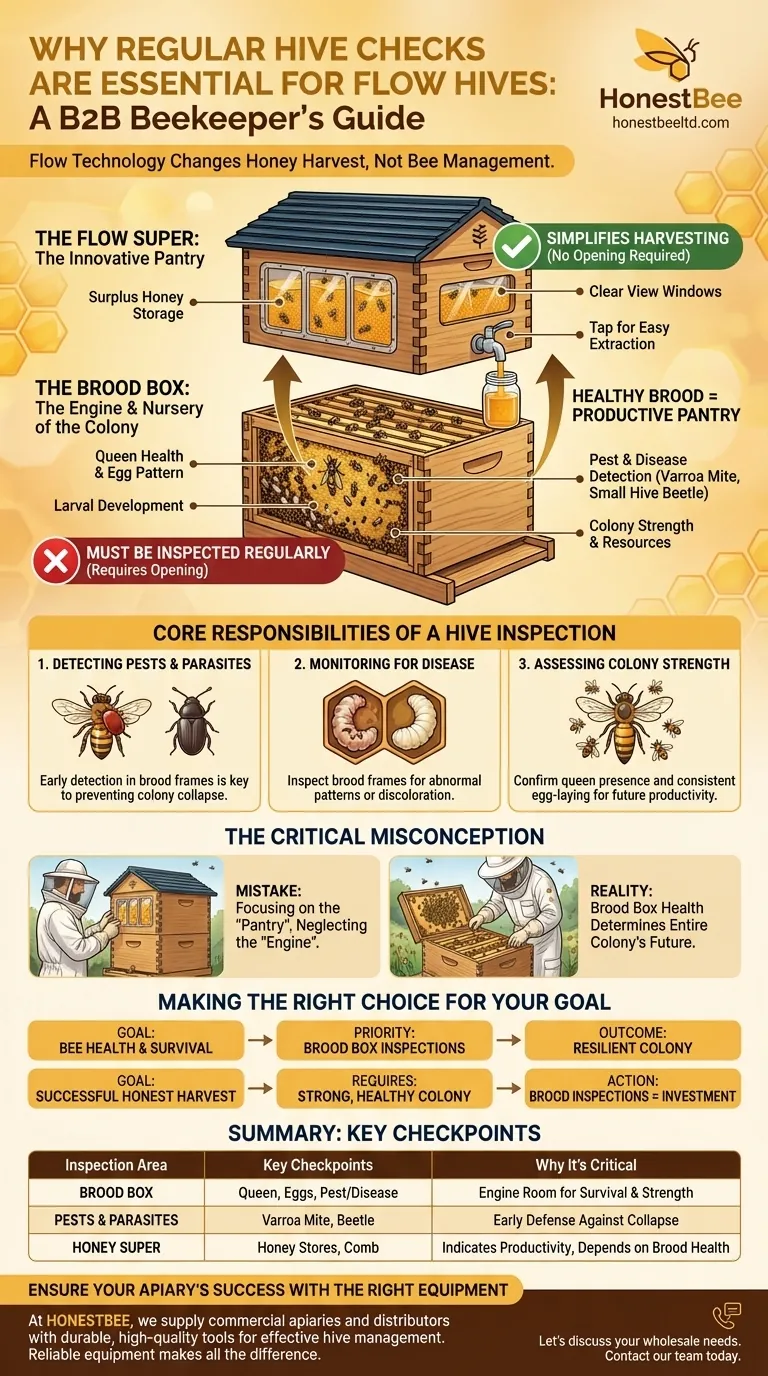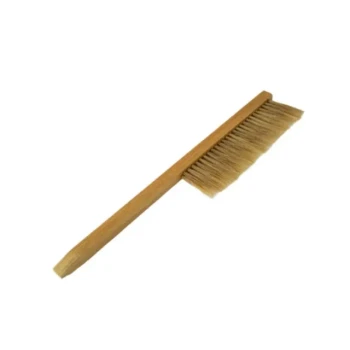In short, regular hive checks are absolutely essential for Flow Hives because the technology only changes how you harvest honey, not how you manage the bees. The health and survival of your colony depend on the same beekeeping fundamentals required for any hive, which involves routine inspections for pests, diseases, and overall colony strength.
The central misunderstanding is viewing the Flow Hive as a self-managing system. In reality, it is a traditional beehive with an innovative honey super. The core responsibilities of beekeeping—managing the brood box where the bees live and reproduce—remain entirely unchanged.

The Flow Hive: A Tool for Extraction, Not a Substitute for Care
To understand the need for inspections, it's crucial to distinguish what the Flow Hive technology actually does.
What the Flow Hive Simplifies
The Flow Hive's key innovation is its specialized frames in the honey super (the box where surplus honey is stored).
A special key is used to split the hexagonal cells within these plastic frames. This allows honey to flow down and out of the hive through a spout, directly into your jar.
This process dramatically reduces stress on the bees during honey extraction. There is no need to open the hive, smoke the bees, or remove heavy frames for processing in a centrifuge.
What Remains Unchanged
The Flow Hive super sits on top of a standard brood box. This brood box is the heart of the colony.
It's where the queen lays eggs, the young bees are raised, and the colony's day-to-day life happens. The bees' life cycle and their vulnerability to external threats are identical regardless of the type of honey super you place on top.
Core Responsibilities of a Hive Inspection
Whether you use a Flow Hive or a traditional Langstroth hive, your inspection goals are the same. You are the primary defense for your colony against common threats.
Detecting Pests and Parasites
Pests like the Varroa mite and small hive beetle can devastate a colony. Varroa mites, in particular, spread dangerous viruses and are a leading cause of colony collapse.
Early detection through regular inspection of the brood frames is the only way to manage these threats effectively.
Monitoring for Disease
Bee diseases often start in the brood nest. You must physically remove frames from the brood box to look for signs of disease, such as abnormal larval patterns or discoloration.
The health of the brood directly determines the future strength and productivity of your entire colony.
Assessing Colony Strength and Queen Health
A proper inspection involves confirming the presence and health of your queen. You look for a consistent egg-laying pattern, which signals a healthy, productive queen and a thriving colony.
Weak or queenless colonies are vulnerable and require intervention. This can only be identified by opening the hive and examining the brood frames.
The Critical Misconception: Two Halves of the Hive
The most common pitfall for new Flow Hive owners is focusing on the "pantry" while neglecting the "engine room."
The Brood Box: The Engine of the Colony
Think of the brood box as the engine and nursery of your hive. Its health dictates everything.
Inspecting it requires lifting off the Flow Super and removing frames one by one, just as you would with any standard hive. This is a non-negotiable part of responsible beekeeping.
The Flow Super: The Pantry
The Flow Super is simply the pantry where bees store excess honey. The Flow technology provides a brilliant window into this pantry and a tap to access it.
However, a full pantry is only possible if the engine room is running at peak performance. Neglecting the brood box in favor of watching the honey super is a recipe for failure.
Making the Right Choice for Your Goal
Your approach to hive checks should be guided by your primary objective as a beekeeper.
- If your primary focus is bee health and survival: Prioritize regular brood box inspections for pests, disease, and queen status above all else.
- If your primary focus is a successful honey harvest: Understand that a strong, healthy colony is the only way to produce surplus honey, making brood inspections a direct investment in your harvest.
Ultimately, successful beekeeping with a Flow Hive is built on the same foundation as any other method: consistent and diligent care for the bees themselves.
Summary Table:
| Inspection Area | Key Checkpoints | Why It's Critical |
|---|---|---|
| Brood Box | Queen health, egg pattern, pest/disease signs | The 'engine room' of the hive; determines colony survival and strength. |
| Pests & Parasites | Varroa mite levels, small hive beetle | Early detection is the only defense against colony collapse. |
| Honey Super (Flow Frames) | Honey stores, comb condition | Indicates colony productivity; health of the brood box enables a full 'pantry'. |
Ensure your apiary's success with the right equipment.
At HONESTBEE, we supply commercial apiaries and beekeeping equipment distributors with the durable, high-quality tools needed for effective hive management—from hive tools and smokers to protective gear. Proper inspections are fundamental, and having reliable equipment makes all the difference.
Let's discuss your wholesale needs. Contact our team today to equip your operation for healthy, productive colonies.
Visual Guide

Related Products
- Professional Grade Foldable Beehive Handles
- Professional Drop-Style Hive Handles for Beekeeping
- Professional Galvanized Hive Strap with Secure Locking Buckle for Beekeeping
- Wooden Bee Brush with Triple Row Artificial Fiber for Beekeeping
- HONESTBEE Heavy Duty All Metal Frame Wire Crimper Tool
People Also Ask
- What is a common hive setup in warmer regions? A Simple, Effective Guide for Healthy Bees
- What equipment is needed to start beekeeping? Your Essential Guide to a Successful Apiary
- When should the first inspection of a new hive be conducted? Ensure a Strong Start for Your Colony
- What month do honey bees come out? Understand Their Spring Emergence & Activity Cycle
- What are some potential benefits of drones in a bee colony? Enhancing Hive Health and Productivity



















